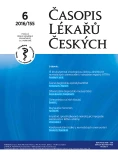-
Medical journals
- Career
Immune mediated necrotizing myopathy associated with statin treatment
Authors: Jiří Vencovský
Authors‘ workplace: Revmatologický ústav
Published in: Čas. Lék. čes. 2016; 155: 319-323
Category: Review Article
Overview
Immune mediated necrotizing myopathy (IMNM) is an acquired inflammatory myopathy. One form of the disease is associated with serum anti-HMGCR autoantibodies and significant proportion of patients has a history of statin treatment. The disease is rare with the incidence estimated around 2−3 cases/100 000 statin treated individuals. In contrast to direct statin toxicity, anti-HMGCR associated IMNM is an induced autoimmune disease.
Patients suffer particularly from severe muscle weakness, which may be occasionally totally immobilizing. Very high serum creatine kinase levels are usually detected. HMGCR (3-hydroxy-3-methylglutarylcoenzyme A reductase) is a pharmacological target of statins and the fact that patients develop autoantibodies against the enzyme suggests a possible effect of statins in induction of HMGCR antigenicity. Muscle histopathology shows predominant muscle fibre necrosis usually without concomitant lymphocytic infiltrates.
Most of the patients require long-term treatment with glucocorticoids or immunosuppressive drugs. In resistant cases use of intravenous immunoglobulins may be necessary as the only effective approach to improve the disease.Keywords:
inflammatory myopathy, muscle necrosis, statins, HMGCR
Sources
1. Dalakas MC. Inflammatory muscle diseases. N Engl J Med 2015; 372 : 1734–1747.
2. Hoogendijk JE, Amato AA, Lecky BR et al. 119th ENMC international workshop: trial design in adult idiopathic inflammatory myopathies, with the exception of inclusion body myositis, 10–12 October 2003, Naarden, The Netherlands. Neuromuscul Disord 2004; 14 : 337–345.
3. Zámečník J, Manďáková P, Cibula A et al. Je to skutečně myozitida? Význam imunohistochemie svalové tkáně v diferenciální diagnostice zánětlivých myopatií. Česká revmatologie 2005; 13 : 138–145.
4. Mammen AL. Statin-associated autoimmune myopathy. N Engl J Med 2016; 374 : 664–669.
5. Christopher-Stine L, Casciola-Rosen LA, Hong G et al. A novel autoantibody recognizing 200-kd and 100-kd proteins is associated with an immune-mediated necrotizing myopathy. Arthritis Rheum 2010; 62 : 2757–2766.
6. Klein M, Mann H, Pleštilová L et al. Increasing incidence of immune-mediated necrotizing myopathy: single-centre experience. Rheumatology (Oxford) 2015; 54 : 2010–2014.
7. Alfirevic A, Neely D, Armitage J et al. Phenotype standardization for statin-induced myotoxicity. Clin Pharmacol Ther 2014; 96(4): 470–476.
8. Grable-Esposito P, Katzberg HD, Greenberg SA et al. Immune-mediated necrotizing myopathy associated with statins. Muscle Nerve 2010; 41 : 185–190.
9. Mammen AL, Chung T, Christopher-Stine L et al. Autoantibodies against 3-hydroxy-3-methylglutaryl-coenzyme A reductase in patients with statin-associated autoimmune myopathy. Arthritis Rheum 2011; 63 : 713–721.
10. Mammen AL. Necrotizing myopathies: beyond statins. Curr Opin Rheumatol 2014; 26 : 679–683.
11. Allenbach Y, Drouot L, Rigolet A et al. Anti-HMGCR autoantibodies in European patients with autoimmune necrotizing myopathies: inconstant exposure to statin. Medicine (Baltimore) 2014; 93 : 150–157.
12. Watanabe Y, Uruha A, Suzuki S et al. Clinical features and prognosis in anti-SRP and anti-HMGCR necrotising myopathy. J Neurol Neurosurg Psychiatry 2016; 87 : 1038–1044.
13. Khan U, Nicell J. Human Health Relevance of Pharmaceutically Active Compounds in Drinking Water. AAPS J 2015; 17 : 558–585.
14. Mammen AL, Pak K, Williams EK et al. Rarity of anti-3-hydroxy-3-methylglutaryl-coenzyme A reductase antibodies in statin users, including those with self-limited musculoskeletal side effects. Arthritis Care Res (Hoboken) 2012; 64 : 269–272.
15. Stenzel W, Goebel HH, Aronica E. Review: immune-mediated necrotizing myopathies – a heterogeneous group of diseases with specific myopathological features. Neuropathol Appl Neurobiol 2012; 38 : 632–646.17.
16. Mammen AL, Gaudet D, Brisson D et al. Increased frequency of DRB1*11 : 01 in anti-HMG-CoA reductase-associated autoimmune myopathy. Arthritis Care Res (Hoboken) 2012; 64 : 1233–1237.
17. Osaki Y, Nakagawa Y, Miyahara S et al. Skeletal muscle-specific HMG-CoA reductase knockout mice exhibit rhabdomyolysis: A model for statin-induced myopathy. Biochem Biophys Res Commun 2015; 466 : 536–540.
18. Werner JL, Christopher-Stine L, Ghazarian SR et al. Antibody levels correlate with creatine kinase levels and strength in anti-HMG-CoA reductase associated autoimmune myopathy. Arthritis Rheum 2012; 64 : 4087–4093.
19. Ramanathan S, Langguth D, Hardy TA et al. Clinical course and treatment of anti-HMGCR antibody-associated necrotizing autoimmune myopathy. Neurol Neuroimmunol Neuroinflamm 2015; 2(3): e96.21.
20. Mammen AL, Tiniakou E. Intravenous immune globulin for statin-triggered autoimmune myopathy. N Engl J Med 2015; 373(17): 1680–1682.
21. Allenbach Y, Keraen J, Bouvier AM et al. High risk of cancer in autoimmune necrotizing myopathies: usefulness of myositis specific antibody. Brain 2016; 139 : 2131–2135.
Labels
Addictology Allergology and clinical immunology Angiology Audiology Clinical biochemistry Dermatology & STDs Paediatric gastroenterology Paediatric surgery Paediatric cardiology Paediatric neurology Paediatric ENT Paediatric psychiatry Paediatric rheumatology Diabetology Pharmacy Vascular surgery Pain management Dental Hygienist
Article was published inJournal of Czech Physicians

-
All articles in this issue
- 15 years’ experience with biological therapy of inflammatory rheumatic diseases in Czech national register ATTRA
- Early diagnosis of spondyloarthritis
- Differential diagnosis of monoarthritis
- Hand osteoarthritis
- Raynaud's phenomenon
- Immune mediated necrotizing myopathy associated with statin treatment
- Cardiovascular risk in rheumatic diseases
- Journal of Czech Physicians
- Journal archive
- Current issue
- Online only
- About the journal
Most read in this issue- Differential diagnosis of monoarthritis
- Hand osteoarthritis
- Raynaud's phenomenon
- Immune mediated necrotizing myopathy associated with statin treatment
Login#ADS_BOTTOM_SCRIPTS#Forgotten passwordEnter the email address that you registered with. We will send you instructions on how to set a new password.
- Career

